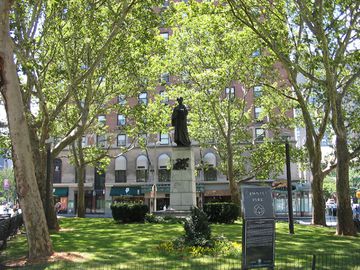

In front of the Lincoln Center of the Performing Arts, right between Columbus Avenue and Broadway, stands a statue in honor of one of the world's greatest poets: the Florentine Dante Alighieri.
However, Dante has very little to do with New York. In fact, he has nothing to do with the city, nor with America. He had died three hundred years before the first Dutch settlers even founded New Amsterdam.
Dante Park is a gift from New York's Italian-American community. The community had originally wanted to put up a bigger, more impressive statue of the poet in Times Square in 1912, but that area was too congested with cars and passersby. Thus the city authorities suggested a more tranquil zone, the Upper West Side.
The commission for the statue was given to Italian sculptor Ettore Ximenes, who finished it for the 600th anniversary of Dante Alighieri's death in 1921. Today the bronze statue finds itself surrounded by trees, and therefore lots of shade, which unfortunately does not allow us to have a good view of the work. Obviously, the landscape has changed in the last hundred years: buildings went up, the lawn around the statue was fenced in and the smog from the traffic has changed the air quality. But nevertheless the poet's gloomy presence can definitely be felt, especially if you take a moment and rest on the benches under the trees.
Italian-Americans are the fourth biggest European ethnic group in the US, and seventh over all. According to a recent census, today there are seventeen million American citizens with Italian roots and in New York City alone there are one million eight hundred Italian-Americans, making them the biggest ethnic group in the Big Apple. From 1820, when Italians began immigrating to America, to the present, almost six million individuals left Italy and settled in the US. The most intense period of immigration occurred between 1880 and 1920, when over four million Italians, mostly from Southern Italy, crossed the Atlantic Ocean. This was immediately after the Italian Unification and the government in Rome even encouraged emigration, first, to solve economic problems, and second, as a foreign policy tool to create ties with the US. Italians obviously did not have an easy time when they arrived: like all immigrants, they had to perform menial tasks and lived in unsanitary conditions. But by the middle of the 1960s they comprised a sizeable portion of America's middle class and by the end of the 20th century many Italian-Americans were occupying the most prestigious posts in state and federal governments.
Today famous Italian-Americans include actors Liza Minnelli, Robert De Niro, Al Pacino and Sylvester Stallone, politicians Mario Cuomo, Nancy Pelosi and Rudy Giuliani and singers Bruce Springsteen and Madonna. But in the 20th century there were also entertainers Dean Martin and Frank Sinatra, film director Frank Capra, composer Henry Mancini, physicist Enrico Fermi, tenor Mario Lanza and baseball star Joe DiMaggio. It is only natural that Italian-Americans make up such a vital part of the US, since it was the Italians who first discovered and explored what is now the US and it is after an Italian that the new country named itself: Amerigo Vespucci.